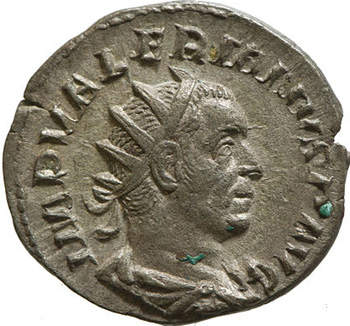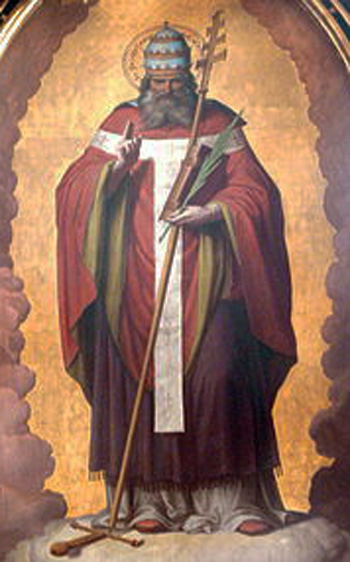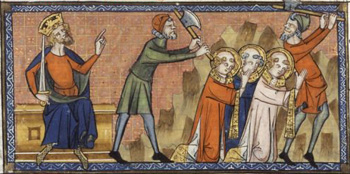The Saint of the Day
 |
 |
 |
 |
 |
 |
 |
St. Sixtus II, Pope - August 6
Biographical selection:
Today we hail the noble Pontiff who was the first of the Popes to enter the arena that Valerian opened for the soldiers of Christ. We are in the year 258. The Emperor has just forbidden all meetings of the Christian religion.
For the first time the Church was attacked as a civil association. By imperial decree her gatherings were considered illicit and became an implacable offense against the Roman Law. The meeting places inside the cities, which were the churches properly speaking, and the cemeteries outside the cities were confiscated by the Empire.
 Facing these interdictions, what was the attitude of the Chief of the Church? To suppress her gatherings would be to jeopardize the very life of the Church! Then, Pope Sixtus II decided that the Church would continue to hold her meetings. He told the faithful to meet as customary in the cemeteries outside Rome.
Facing these interdictions, what was the attitude of the Chief of the Church? To suppress her gatherings would be to jeopardize the very life of the Church! Then, Pope Sixtus II decided that the Church would continue to hold her meetings. He told the faithful to meet as customary in the cemeteries outside Rome.
It was in a crypt of St. Calixtus Cemetery that, on August 6, 258, Roman soldiers set upon him as he celebrated the sacrifice of the Mass amidst the faithful. The Catholics present tried to protect him, but the soldiers killed him immediately along with the four Deacons who assisted him.
Two other Deacons - Felicissimus and Agapitus - were victims of the same violent assault and were buried in Pretestatus Cemetery. The seventh Deacon, Lawrence, was murdered some days later.
St. Sixtus was buried at the site of his martyrdom. The crypt became known as the "Crypt of the Popes," one of the holiest places in the Eternal City. It became perhaps the most popular tomb of the martyr Popes.
The cult of Pope St. Sixtus II started on the very day of his death. In times past in Rome there were two customs practiced on in this day: One was to visit St. Calixtus Cemetery where the Pope and his four Deacons rest; the other was to go to the Cemetery of Pretestatus where the other Deacons were buried. (Dom Guéranger, The Liturgical Year)
Comments of Prof. Plinio:
Should St. Sixtus II have obeyed the imperial decree, the very life of the Church would have been jeopardized because the Catholics would no longer be able to meet. We should point out that priests could still go to baptize the faithful and offer the other Sacraments as long as they did not meet together. Only the meetings were forbidden. There was not, therefore, a prohibition of the cult, of the worship; this first measure was just a prohibition of the meetings.
A Pope without zeal could say: "Look, we share a common point with this Emperor. He will allow the cult… but only for individuals, inside each home. We do not need to shed torrents of blood just to hold our meetings. We can make arrangements for the priests to teach the Catechism and administer the Sacraments in each home, and then quietly leave. If we have the priests and the faithful, we have all that we need. Why hold meetings? Let us end with them."
 The persecution that unfolded was against the meetings. It was this decree that St. Sixtus II resolved to oppose. He was a truly saintly Pope - not an ecumenical Pope - who resolved to resist and calmly proceeded to celebrate Mass in a forbidden place.
The persecution that unfolded was against the meetings. It was this decree that St. Sixtus II resolved to oppose. He was a truly saintly Pope - not an ecumenical Pope - who resolved to resist and calmly proceeded to celebrate Mass in a forbidden place.
We can imagine a Mass celebrated by a Saint Pope with several Deacons who were also Saints. It is not a common scene for us…
Suddenly the soldiers sent by the Roman Emperor enter. The people try to protect the Celebrant. He dies a victim on the very Altar upon which he was preparing to immolate the Divine Victim. It is truly something beautiful! It is a scene that triggers our enthusiasm!
One of the Deacons was the famous St. Lawrence who was martyred on a grill.
St. Sixtus was buried at the site of his martyrdom. This is very beautiful as well.
A progressivist would say: "See what the imprudence of this Pope caused! He and his Deacons were killed as a fruit of his imprudence. Would it not be better to take an ecumenical approach?"
St. Sixtus is in the highest place of Heaven praying for us. He engaged the Church on the path of resistance and martyrdom. I ask you: What would the Church be if she did not have this avalanche of martyrs whom we admire?
So then, was this not the true path? Yes, of course it was. St. Sixtus was inspired by the Holy Spirit to open that path, which in the long run would give the Church millions of martyrs, establish our Holy Faith as the True Faith and convert the Roman Empire.
 This raises the question: Will not the path of resistance and martyrdom be the path for us in determined circumstances?
This raises the question: Will not the path of resistance and martyrdom be the path for us in determined circumstances?
You are seeing that we are being prepared to enter the "era of Judas." Our duty will be, with the favor of Our Lady, to walk the path of resistance and even possible martyrdom, and to say: "No, no, a thousand times no!"
May Our Lady give us strength to hold steadfastly to this position until the end. We cannot wish for anything better than this in our lives. Then, at the moment of death, we will be able to paraphrase the words of Job: "Blessed be the day that saw my birth; blessed be the stars that watched me as a child; blessed be the moment that my mother said: a man child is born." Because this is what it is to truly live!
May Our Lady help us to fulfill this duty. Let us remind ourselves that the specific intention of our adoration of the Holy Sacrament on Saturday nights at the Carmelite Basilica is this: to receive the grace to fulfill our duty, to resist Progressivism in the Church and to even face martyrdom if necessary.


The Saint of the Day features highlights from the lives of saints based on comments made by the late Prof. Plinio Corrêa de Oliveira. Following the example of St. John Bosco who used to make similar talks for the boys of his College, each evening it was Prof. Plinio’s custom to make a short commentary on the lives of the next day’s saint in a meeting for youth in order to encourage them in the practice of virtue and love for the Catholic Church. TIA thought that its readers could profit from these valuable commentaries.
The texts of both the biographical data and the comments come from personal notes taken by Atila S. Guimarães from 1964 to 1995. Given the fact that the source is a personal notebook, it is possible that at times the biographic notes transcribed here will not rigorously follow the original text read by Prof. Plinio. The commentaries have also been adapted and translated for TIA’s site.
Today we hail the noble Pontiff who was the first of the Popes to enter the arena that Valerian opened for the soldiers of Christ. We are in the year 258. The Emperor has just forbidden all meetings of the Christian religion.
For the first time the Church was attacked as a civil association. By imperial decree her gatherings were considered illicit and became an implacable offense against the Roman Law. The meeting places inside the cities, which were the churches properly speaking, and the cemeteries outside the cities were confiscated by the Empire.

Emperor Valerian ordered
the murder of St. Sixtus II
It was in a crypt of St. Calixtus Cemetery that, on August 6, 258, Roman soldiers set upon him as he celebrated the sacrifice of the Mass amidst the faithful. The Catholics present tried to protect him, but the soldiers killed him immediately along with the four Deacons who assisted him.
Two other Deacons - Felicissimus and Agapitus - were victims of the same violent assault and were buried in Pretestatus Cemetery. The seventh Deacon, Lawrence, was murdered some days later.
St. Sixtus was buried at the site of his martyrdom. The crypt became known as the "Crypt of the Popes," one of the holiest places in the Eternal City. It became perhaps the most popular tomb of the martyr Popes.
The cult of Pope St. Sixtus II started on the very day of his death. In times past in Rome there were two customs practiced on in this day: One was to visit St. Calixtus Cemetery where the Pope and his four Deacons rest; the other was to go to the Cemetery of Pretestatus where the other Deacons were buried. (Dom Guéranger, The Liturgical Year)
Comments of Prof. Plinio:
Should St. Sixtus II have obeyed the imperial decree, the very life of the Church would have been jeopardized because the Catholics would no longer be able to meet. We should point out that priests could still go to baptize the faithful and offer the other Sacraments as long as they did not meet together. Only the meetings were forbidden. There was not, therefore, a prohibition of the cult, of the worship; this first measure was just a prohibition of the meetings.
A Pope without zeal could say: "Look, we share a common point with this Emperor. He will allow the cult… but only for individuals, inside each home. We do not need to shed torrents of blood just to hold our meetings. We can make arrangements for the priests to teach the Catechism and administer the Sacraments in each home, and then quietly leave. If we have the priests and the faithful, we have all that we need. Why hold meetings? Let us end with them."

St. Sixtus II was not an ecumenical pope
We can imagine a Mass celebrated by a Saint Pope with several Deacons who were also Saints. It is not a common scene for us…
Suddenly the soldiers sent by the Roman Emperor enter. The people try to protect the Celebrant. He dies a victim on the very Altar upon which he was preparing to immolate the Divine Victim. It is truly something beautiful! It is a scene that triggers our enthusiasm!
One of the Deacons was the famous St. Lawrence who was martyred on a grill.
St. Sixtus was buried at the site of his martyrdom. This is very beautiful as well.
A progressivist would say: "See what the imprudence of this Pope caused! He and his Deacons were killed as a fruit of his imprudence. Would it not be better to take an ecumenical approach?"
St. Sixtus is in the highest place of Heaven praying for us. He engaged the Church on the path of resistance and martyrdom. I ask you: What would the Church be if she did not have this avalanche of martyrs whom we admire?
So then, was this not the true path? Yes, of course it was. St. Sixtus was inspired by the Holy Spirit to open that path, which in the long run would give the Church millions of martyrs, establish our Holy Faith as the True Faith and convert the Roman Empire.

The martyrdom of Deacons Felicissimus & Agapitus
You are seeing that we are being prepared to enter the "era of Judas." Our duty will be, with the favor of Our Lady, to walk the path of resistance and even possible martyrdom, and to say: "No, no, a thousand times no!"
May Our Lady give us strength to hold steadfastly to this position until the end. We cannot wish for anything better than this in our lives. Then, at the moment of death, we will be able to paraphrase the words of Job: "Blessed be the day that saw my birth; blessed be the stars that watched me as a child; blessed be the moment that my mother said: a man child is born." Because this is what it is to truly live!
May Our Lady help us to fulfill this duty. Let us remind ourselves that the specific intention of our adoration of the Holy Sacrament on Saturday nights at the Carmelite Basilica is this: to receive the grace to fulfill our duty, to resist Progressivism in the Church and to even face martyrdom if necessary.

 | |
|
|
The texts of both the biographical data and the comments come from personal notes taken by Atila S. Guimarães from 1964 to 1995. Given the fact that the source is a personal notebook, it is possible that at times the biographic notes transcribed here will not rigorously follow the original text read by Prof. Plinio. The commentaries have also been adapted and translated for TIA’s site.


